Abadeh
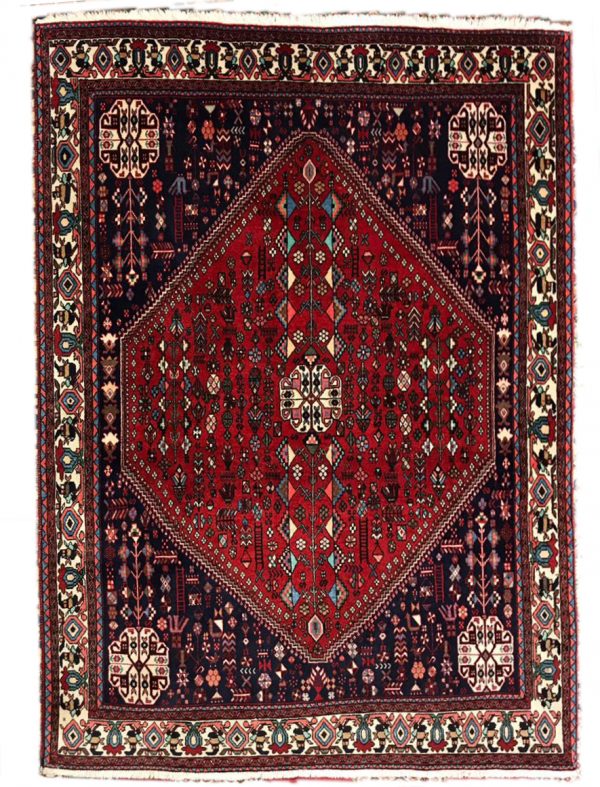
This hand-knotted rug is made in Abadeh, a city located between Isfahan and Shiraz. The abadeh pattern is very similar to the tribal rugs used in this region, which are made with cotton thread and fabric. This motive was mostly taken from the Qashqai tribes. The most common pattern is the geometric medallion on a red background, which fills almost the entire surface of the rug. Within this large pattern, several geometric motifs exist, such as statues, flowers, human figures, trees, and so on. The most typical Abadeh pattern features a large diamond-shaped medallion in the center and four smaller ones in the four corners of the rug, as shown. Its main colors are red, rust brown, blue, white, and very good quality wool is used for weaving.These types of rugs are usually small in size, they rarely make larger sizes. The abadeh is a mid-priced hand-knotted rug. The weaving quality is usually 150,000-200,000 knots / m2.
Ariana

Ariana rugs are made by the most exclusive rug workshops in Pakistan. They employ the highest quality wool with high quality vegetable dyes. Most designs are from inspired by the late 18th century Sultanabad designs of Persian, employing an allover flower pattern throughout the field of rug, usually without a central medallion.
Goliana rugs are similar designs produced in the same workshops but with a finer weave. Goliana rug employing the North-west Persian garden carpet design from the eighteenth century. The original rug can be found in the Victoria and Albert Museum in London.
These exclusive rugs will be available at Bizsan Carpet Gallery!
Avant-garde

This collection of exclusively handmade modern Avantgard designs has been inspired by both, from classical Persian motifs recreated with modern appeal with precision and a desire for high quality craftsmanship by the master workshops in India. These handmade rugs utilize the traditional technique of hand-spin the wool yarn giving a subtle color gradient in the carpet overall palette. High quality wool or exclusive merino wool utilized in these rugs give both durability and permanence. This attention to detail by both designers and craftsman is reflected in the overall balance of color, design and atmosphere these rugs create wherever they may be placed. The qualities offered vary in range according to fineness, wool quality and design execution.
Bakhtiari
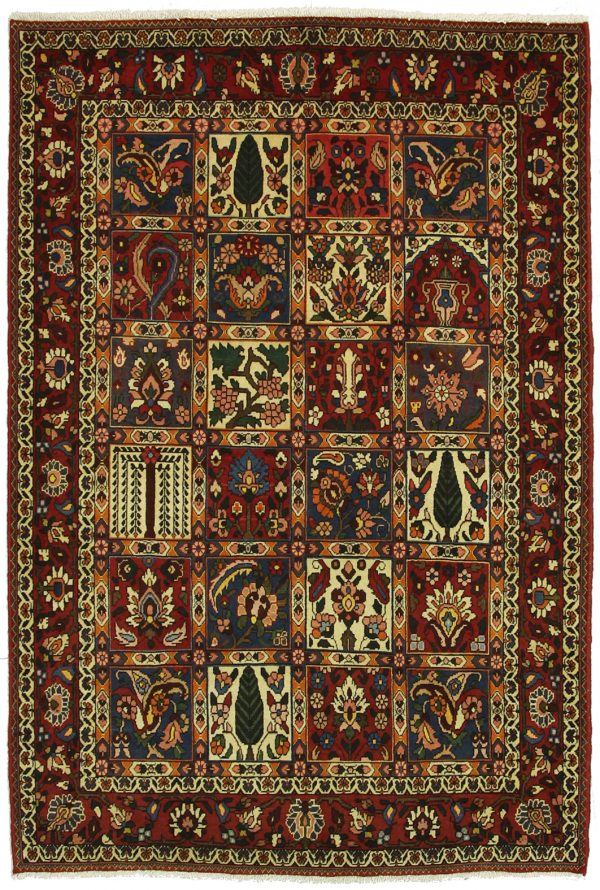
Bakhtiari rugs are woven in numerous villages in a large area southwest of Isfahan known as Chahar Mahal. These rugs are woven by Bakhtiari tribes as well as other Persians. The most common designs are the medallion, panel and lozenge designs. Variety of motifs and colors are employed in these rugs. Motifs such as flowers, trees, botehs, birds, palmettes and other animals exhilarate the viewer. The main colors employed are usually a variety of rust-red tones and brown and maroon.
However, blue, green, orange and white also add richness to these exotic rugs. The quality of Bakhtiari’s can range as do their prices. The finest quality ones are woven in the village of Chalshator. The wool quality of the pile of Bakhtiari’s are durable and ideal for traffic. They are often utilized under a dining table because of their strength and durability.
Balouch
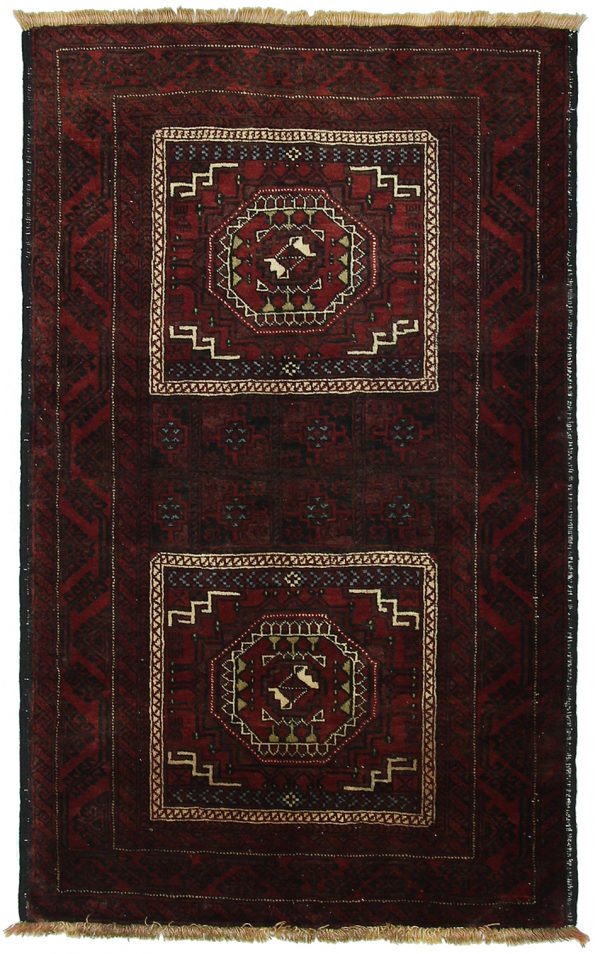
Balouchi, (Baluchi) rugs come from the Khorasan region in the eastern part of Iran. They are knotted by the nomadic / semi-nomadic peoples living in this expansive region. Typical Balouchi rugs are easy for even the non-expert to distinguish. They are almost exclusively small and have very dark coloring. Dark brown shades and dark blue with orange and red accents dominate. Many Balouchi rugs are knotted using the prayer niche pattern, the mihrab. the inner fields may comprise of a field of geometric shapes or herati patterns. Asymmetric knots are used frequently. Like the pile, the basic weave consists of pure wool and usually has two wefts after every row of knots.Distinctive kelim borders at both ends of the rug are typical of this provenance and often have very lavish designs using various flat-weave techniques.
Beljik

Belgique (Beljik) rugs are one of the finest quality Afghan rugs produced in Afghanistan. They are similar in design to Khal-Mohammadi rugs employing a mixture of geometric and floral designs, however, they are distinguishably different not only due to the fine and precise knot employed and executed on Belgique rugs, which may range between 300,000-400,000 knot / m2 but rather they are one of the few rugs produced in Afghanistan that employ the finest imported New Zealand merino wool. Due to the excellent quality wool utilized in Belgique rugs, it is foreseen that they will be very durable and will continue to sustain there value in the future.
The production of Belgique rugs are generally limited in number.
Bidjar
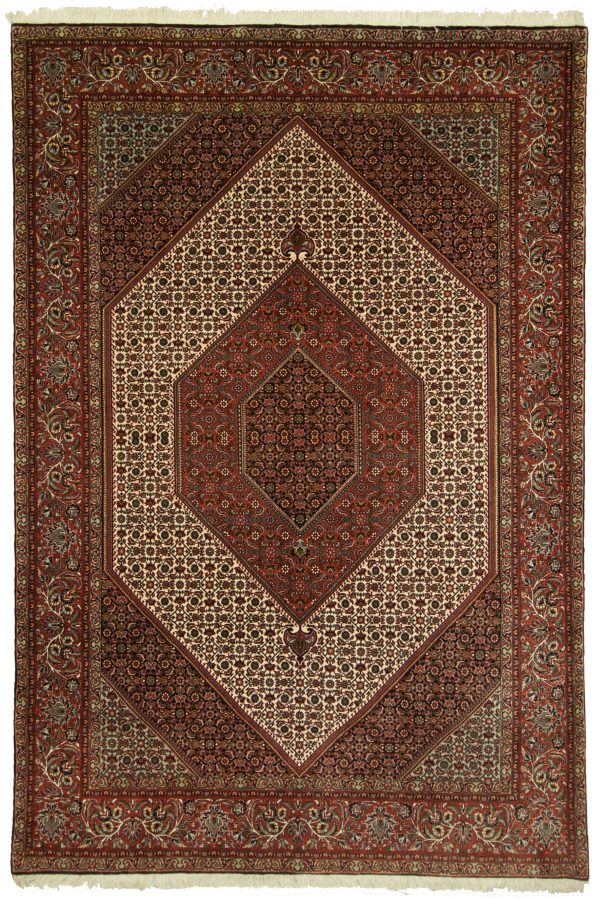
Bijar (Tekab, Afshar, Zanjan): This small town consisting of approximately 50,000 inhabitants has in the last century built a reputation as the most durable rug built on the planet and for this reason they are referred to as “the iron rugs of Persia! ” At the turn of the Century this small town consisting mainly of Kurds began to become the weaving center of many variations of Safavid inspired designs including the ‘Mina khani’ and ‘Herati’ and the integration of rose spandrels sometimes referred to as’ Gol- e- These handmade rugs are renowned for their heavy and tight weave, excellent construction and excellent wool quality.
The tightness of the Bijar’s are due to the use of an extra weft by the local weavers which are wet and pounded down for extra firmness and compaction creating a surface in which the pile does not lay down, creating a soft cushiony feel to the surface which cannot be compared to other rugs. Antique and older olir’s have much more coarser feel (usually 150,000-300,000knots / m2) and are not as fine as there modern counterparts which can have a knot count of 500,000-1,000,000 knots / m2. The finest and most expensive types of olir’s are the Bukan / Tekab which are produced by the best weavers and uttlize the highest quality materials.
Two particularly unique and prized older Bijar designs are “Garrus” and “Guli Farang.” The Garrus designs usually utilize a navy indigo blue field with a unique all-over pattern of split-arabesques and blossoming vinery in the field. Bijar rugs are woven by both man and women and some are referred to as “mardbaft” meaning that they were hand-knotted by men!
Newer Bijar designs integrate precise herati motifs either spread out throughout the field of rug or integrated with several diamond shaped central medallions. There are some rare pieces available with floral motifs outlined with fine silk. Bijar’s traditional colors are red, blue and creams. Bijars are becoming rare and it is foreseeable that they will become collectible items in the near future since antique olirs have consistently received very high bids at both Sotheby’s or Christies Auctions.
Bizsan Indo
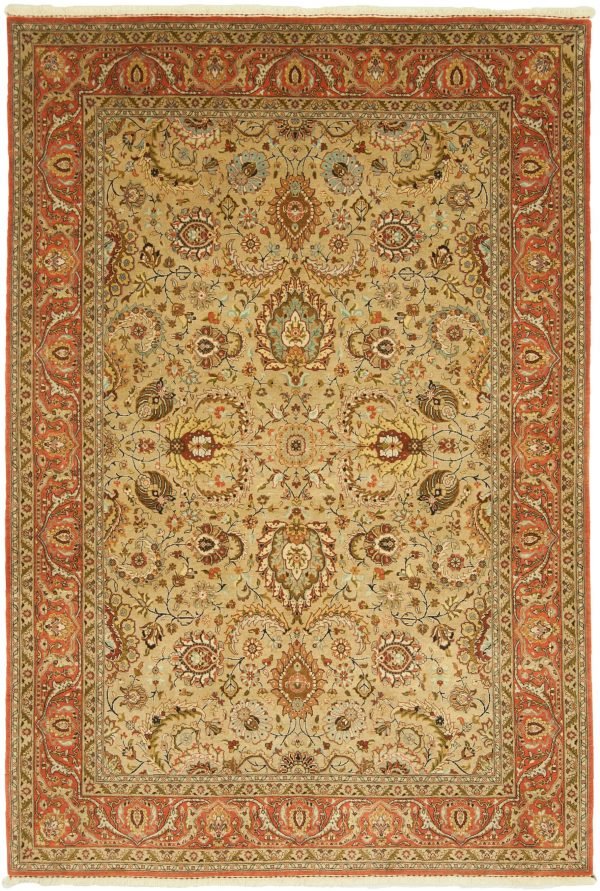
This collection of exclusively handmade Persian designs inspired from the master workshops of the late 19th century of Tabriz, Sultanabad, Sarough and Kashan have been recreated again with precision and a desire for quality by the master workshops in India. Utilizing the traditional technique to hand-spin the wool yarn gives subtle color gradients in the carpet overall palette. High quality wool or merino wool imported from wool producers in the world and utilized in these rugs give both durability and permanence. This attention to detail by both designers and craftsman is reflected in the overall balance of color, design and atmosphere these rugs create wherever they may be placed. The qualities offered vary in range according to fineness, wool quality and design execution.
Bizsan Modern
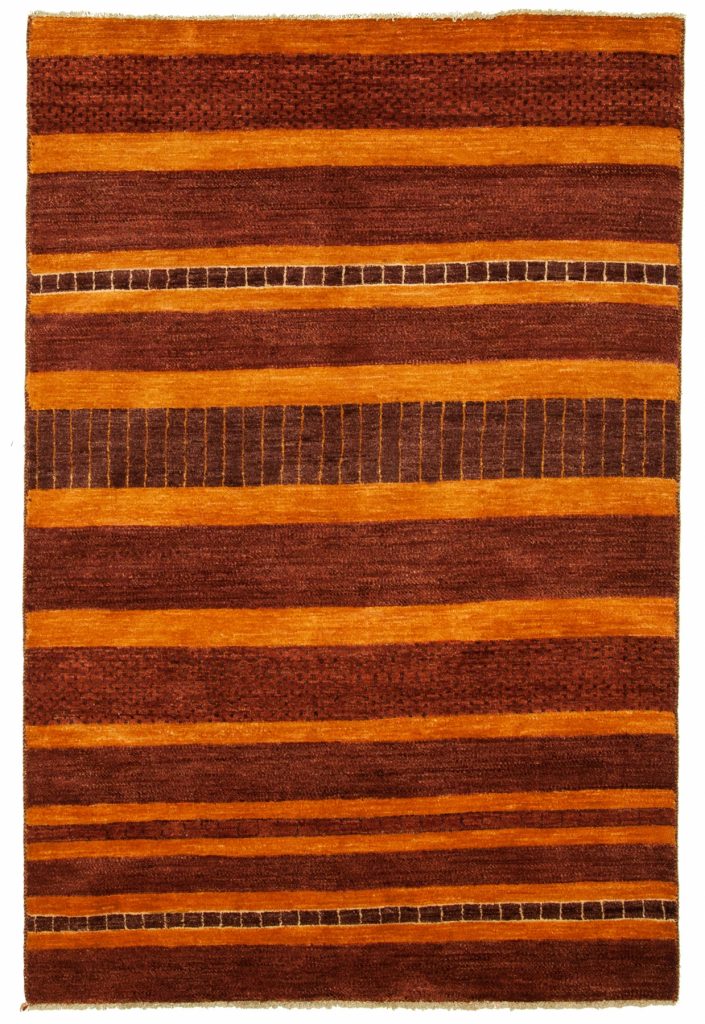
These are modern rugs produced in Pakistan among the tribal people living in the Peshawar region. They employ the Persian knot and utilize good quality lustrous wool. There are a variety of modern rugs that are designed by Bizsan designers which can be found in our modern gallery. The finer quality pieces use hand-spun wool which gives a marbling effect to the overall design of these rugs. Some pieces are inspired from the 1930-40’s deco rugs that were produced to accompany the deco architecture and furniture of this period. These earlier rugs were produced in many places including Western-Europe, China and even North-Africa. The knotting is usually from 100.000-250.000knots/m2. Though the quality is slightly better than Iranian Gabbeh’s, these are usually more reasonable in price.
Caucasian

The Caucasus republics of Armenia, Georgia, Azerbaijan and Chechnya as well as Dagestan produced Caucasian handmade rugs as far back as the period of the Persians since they were at one time ruled under one empire. Most of the antique valuable handmade rug specimens available come from the 19th to early 20th century. The most valuable pieces are known as Kazak, Karabagh,Gendje, Talish, Mogan, Shirvan, Baku, Kuba, Dagestan, and Lesghistan. Most of these collectible pieces utilize vegetable dyes and have very beautiful contrastive vibrant color combinations. The handmade rugs known as Shirvan are wooven quite fine and have durable soft lustrous wool. They are renowned for their particular geometric shapes and designs which include many variations of prayer arch motifs in a field of geometric shapes.
Although some pieces were produced during the Soviet Union times, the color combination and designs are not comparable to the latter types. Due to the domestic unrest today in this region, most Caucasian designs are mainly produced in Pakistan in diverse designs and qualities. At Bizsan Carpet Gallery we call these unique pieces Caucasian Pak. In Pakistan there are a large variety of Caucasian design rugs produced in varying qualities with varying prices according to the wool quality, density, design.
Is the identity given to Bizsan’s finest quality Caucasian inspired designs produced in Pakistan reminiscent of the fine quality Shirvan rugs produced during the end of the 19th century. The colors of these rugs are reflective of the vibrant vegetable dyes utilized by rugs produced in this region. The knot is both fine and tight and the pile cut short, creating crisp vibrant geometric designs adding a decorative appeal wherever such rugs are placed.
Chinese Silk

The manufacturing of the fine quality silk carpets in China started 25-30 years ago, for which the best quality silk produced in the country is used. For most of the designs Persian motifs adopted from Iranian master workshops are used (Tabriz, Qom, Isfahan, Kerman Ravar). The most typical motifs show the Garden of Paradise or a garden scene. Flower motifs appear as well, covering the surface of the carpet, either with or without medallion in the middle. A fineness of the Chinese rugs is usually measured by the number of yarns (threads) in one foot (30,48 cm). The most well-known fineness-types are marked as 150, 260, 300, 400; more rare are the 500, 600, 700, 800 yarn carpets. A carpet with 300 yarns has around 1 million knot/m2, as there is 300 yarns in a foot (305 mm), which results in 1 knot/mm2. The quality of the silk is excellent, which gives the carpets durability and permanence.
The more fine ones (with 500-800 yarns) take a lot of time and specialized knowledge, therefore they are not profitable for most of the workshops, so they become more and more rare. Nowadays the most common type is the one with 150-200 yarns, which rugs are beautiful and are available at a fair price. These carpets keep their value very well and will be more available as the silk manufacturing in Iran is decreasing, and the value of the carpets are rising as time goes by.
Djozan

Djozan handmade rugs are produced in the Arak region which is located 297 kilometers southwest of Tehran. The structure of Djozan rugs are very similar to fine handmade Sarough rugs produced in this region. Most of these rugs use the typical red, blue and beige colours with a floral pattern and a central medallion. The wool quality of Djozans are typically very good and hard wearing. Most of Djozan rugs are knotted with symmetrical knot ranging from 200.000 Knots/m2-350.000 Knots/m2.
Ghom / Qom
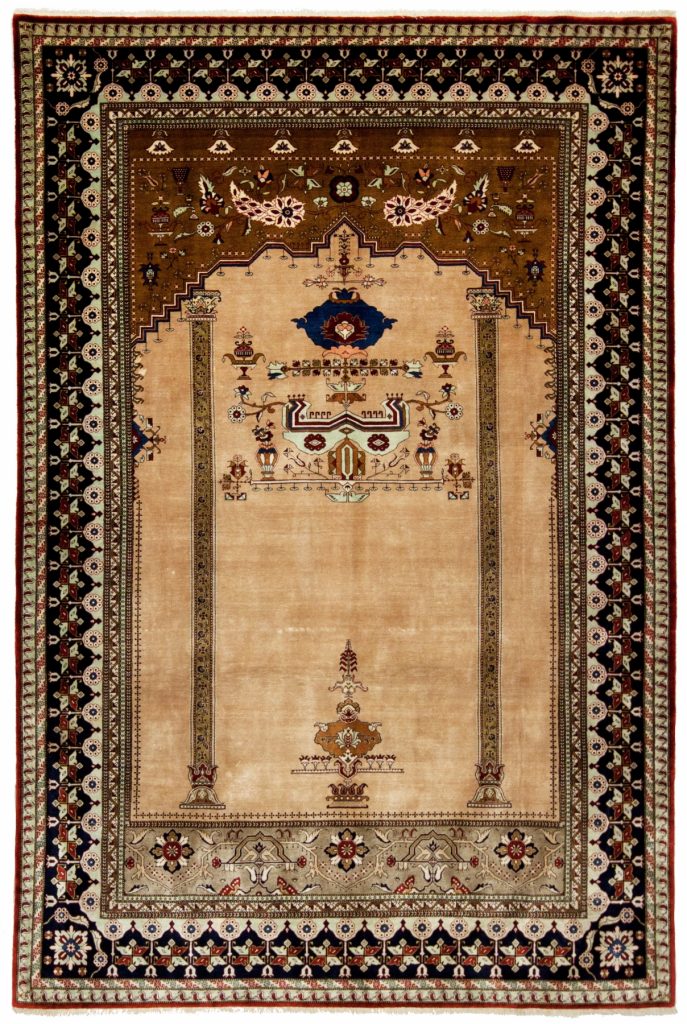
Ghom(Qom) This is a rug production area approximately 150 km south of Tehran. This city(Qom) is also one of the holiest cities of Iran. Production of rugs started in 1930′s by Kashan weavers. Both wool and silk rugs are produced, however Qom recently became famous for its unique silk designs produced by a host of master workshops in this city. Today Qom is the producer of the greatest number of silk rugs with the most variety of designs produced in the world. These exceptional pieces represent the highest level of craftsmanship utilizing the finest quality of wool and silk available for the pile. The designs are crisp and well executed. The designs utilize figurative designs(depicting hunting patterns), garden of paradise, tree of life, or typical central medallion sometimes reminiscent of the unique motifs of Persian tile-filled domes in mosques and old bazaars. Prices for this exclusive pieces may range according to quality, workshop name and fame, and the general beauty of design executed in the field of the rug.
The typical pieces are 800 000-1100 000 knots per square meter however there are unique pieces that are woven up to 1.500.000knots/m2. All sizes are woven from prayer mats to large hall pieces(2x3m,3x4m,and larger).
Hamadan

Hamadan, one of the oldest settlements in the world, originally known as Ecbatana, being the capital of the Median kingdom in the 6th century B.C. The tombs of Esther and Mordecai are located in Hamadan. Both geometric and curvilinear designs are produced in this region. Medallion design, boteh’s and herati patterns are used extensively. The weave is usually coarse to medium but some small amounts are produced in high quality. Though usually coarsely woven, these rugs are respected for their durability because of the good-quality wool used in the pile. The majority of hamadans are woven in small sizes. The larger sizes are usually more expensive due to their scarcity.
Heriz
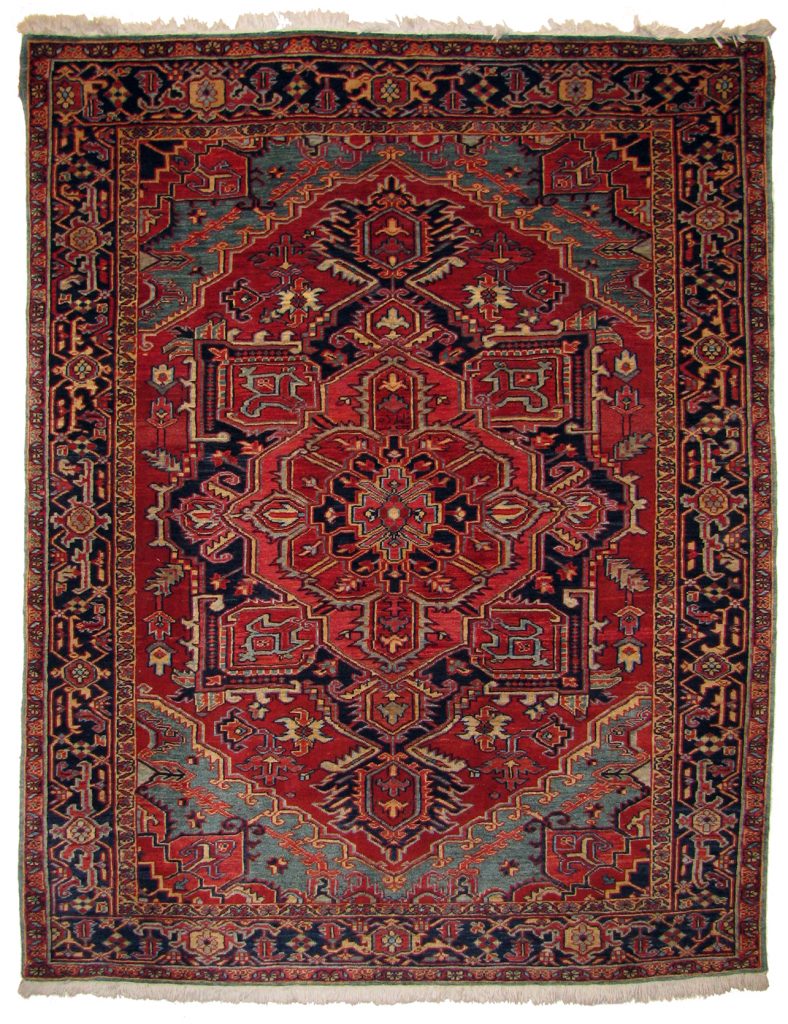
Heriz weaving area is approximately 60 km east of Tabriz. There are villages who produce similar design rugs around Heriz but with different qualities. The best quality are known as Heriz and the inferior but with similar design are Meriban, and Gorevan(a cheap and rather coarse variation of the Heriz). The designs woven in this area is composed of a large geometric medallion with stylized palmette leaves in the field. The borders are similar to Tabriz Mahi rugs and Bijars which have the typical Herati border pattern. In the beginning of the 20th century there was a particular Heriz type of rug named Serapi. They were much finer in weave and wool quality and because of this there values have risen extraordinary in the last 20 years. They have been sought after by collectors and designers because of the beautiful subtle vegetable dyes incorporated in these splendid usually large rugs. Serapi denotes a type of Heriz rather than an actual workshop or village.
Today Bakhshayesh, a village in the Heriz area stands out by creating contemporary magnificent vegetable dye rugs similar to those created by the Serapi weavers. These are becoming rarer even today because of the limited number of pieces that are woven. They will definitely become as collectible as are the Serapi’s!
Both Heriz rugs and Bakhshayesh rugs are usually thick, large knotted and will withstand wear and tear quite well. Although these rugs have similar designs, it is amazing that no two pieces are quite the same!. Heriz designs utilize either soft or strong tones of pink, khaki, ivory, and light and dark blue.
Although Bakhshayesh rugs utilize similar designs to Heriz rugs however, the Bakhshayesh rug field is usually sparsely filled and because they utilize vegetable dyes Bakhshayesh rugs are more vibrant in there color scheme. In Europe these rugs are often used under dining tables or large halls. Today very few Heriz and Bakhshayeshes are available in the market due to the limited production and most Herizes that can be found are usually 20-40 yeras old! They are usually woven in large sizes from 2mx3m to 4mx6m.
Isfahan

Isfahan rugs are knotted on either silk or cotton foundations, with up to 1.000.000 Persian knots per sqm, using exceptionally good quality (Often Kurk) wool for the pile, which is normally clipped quite low. In contemporary items the palette is normally more pastel, and technical perfection is generally of greater importance than artistic flair. Contemporary Isfahan’s are however extremely attractive, and the subduing of the palette, particularly the elimination of strong reds, makes them more compatible with Western decorative schemes.
A range of traditional designs are still used including allover Shah Abbas, Vase, Tree of Life and Pictorial schemes but by far the most popular composition is based on a circular central medallion (Derived from the famous mosque of Shah Lutf Allah in Isfahan) set against an elegantly sculpted field decorated with intricately purling vine palmette and flor motifs.
Antique/ semi-Antique rugs of Isfahan are more colorful and richer in tone than that of Nain, a nearby city renowned for its exceptional handmade rugs. Antique Isfahan’s are quite sought after since production had been almost completely been halted since 1722, during which the Afghan invasion occurred. It was not until the beginning of the 20th century that it was firmly reestablished.
Shah Abbas the Great was an inspired King of the Safavid dynasty, and in consequence not only moved the capital of Persia to Isfahan from Qazvin but also started a artistic renaissance within the capital of his court. Under his vision and guidance carpet weaving in Isfahan flourished. However the Afghan invasion dealt a serious blow to this industry which it never recovered from until the beginning of the 20th century. Some early pieces created in the last century can be found which consist of 500.000knots-1.000.000knots/m2, however these are rare and few in number. World war I brought a change in “modern” Isfahan which was the center of weaving for the fashion industry of Iran. The change of fashion in the world also influenced Iran, causing Isfahan to loose its lucrative fabric industry. However, the shrewd businessman of Isfahan decided to utilize the fine quality wool in fabrics and Aba’s into high quality persian rugs which again reestablished Isfahan as a base for one of the finest and most beautiful carpets of Iran.
Persian court with King and mulla’s wearing aba’s
Many of the designs which consisted of medallions, tree of life, and vase designs reflected the tiles found on the beautiful architecture of the Safavid period.
Sheikh Lutfollah Mosque: Construction of the mosque started in 1603 and was finished in 1619. It was built by the chief architect Shaykh Bahai, during the reigh of Shah Abbas I of the Safavid dynasty. Many of the tiles of the architecture of this period served as inspiration for the carpet designers of Isfahan of the early 20th century.
Kargahi

Kargahi rugs are generally known as nomadic rugs woven by Turkaman tribes settled in the northern part of Afghanistan. They generally consist of geometric designs adopted from the Caucasian regions from the 18th to the 20th century. They employ vegetable dyes on good quality lustrous wool. The colours utilized are generally varying hues of terracotta, rust brown, blue, green and beige.
Kashan
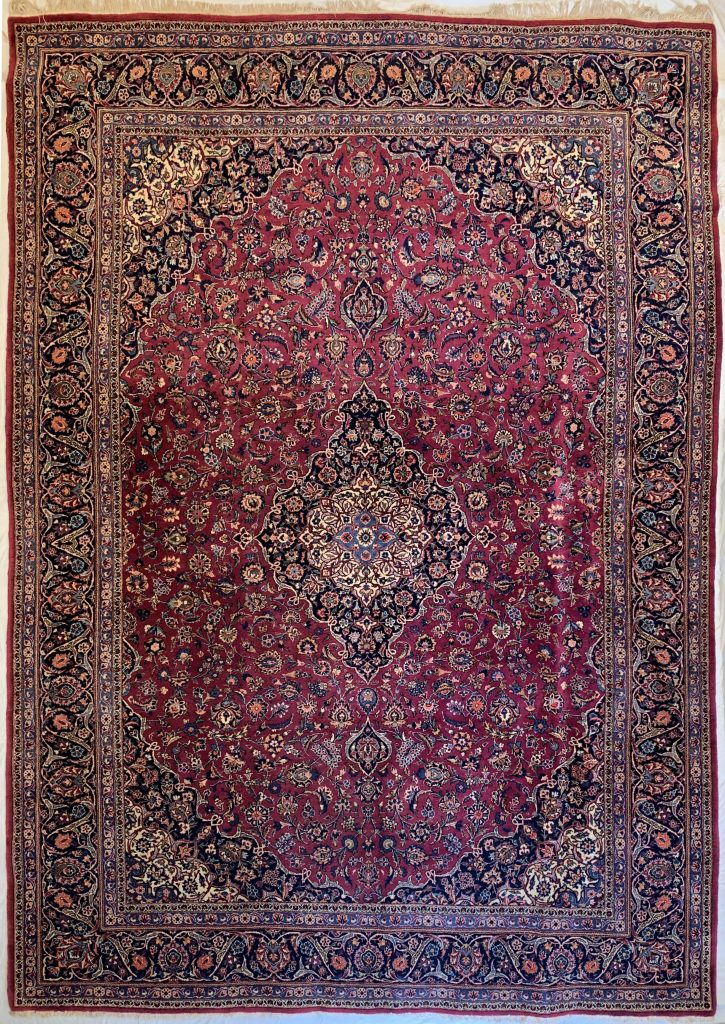
The City of Kashan is approximately 300km south of Tehran. For hundred of years this town has been renowned for its handmade carpet weaving industry. The carpet quality varies according to the workshop and material quality but typically Kashans are renowned for their durability and excellent weave execution. The wool quality is also typically one of the best utilized in Iran. The most common design of Kashan rugs is a floral profusion of vines, tendrils and arabesques utilized throughout the field of the carpet. There are also tree of life designs, vase motifs, boteh motifs and and even pictorial rugs are also woven in Kashan.
The traditional colors of Kashan rugs are dark blue and red or dark and light blue with beige is typically utilized. Kashan rugs can be found in all sizes from small mats to large hall-size pieces.
The most famous Kashans are known as Motashem Kashans; which were woven in the last part of the 19th century. These rare specimens have excellent quality wool and are finely woven with beautiful vegetable dyes. They have often been put on auction at Sotheby’s and Christie’s because they are highly sought after by collectors. They often reach quite high prices due to there rarity and beauty!
Kashkouli

At present these are one of the finest examples of vegetable dyed tribal rugs utilizing high-quality wool. Handmade by traditional Lori and Qashqai tribesmen in the Fars district. Each piece uniquely different from the next, designed according to the weavers feelings, symbolizing their tribal simple yet pure way of life. They represent the European saying that “Less is More!”. However it should be noted that these simple design rugs were available even during the before the 19th century however collectors took little recognition of them until approximately 20 years ago when Gabbeh rugs came into fashion all over Europe. These rugs usually employ a variety of primitive geometric designs such as animals, flowers, and geometric motifs usually in a field of a few primary vegetable colors. Sometimes there are divergent color tones in the carpet purposely utilized to give the rug a rustic painted effect. Also the use of handspun wool is used giving the rug a marbling or abrash effect. These tonal changes are also due to the use of vegetable dyes which gives it a real exotic tribal feel. The quality of wool used is excellent and the knotting is usually 200.000-300.000 knots/m2.
Kashmar
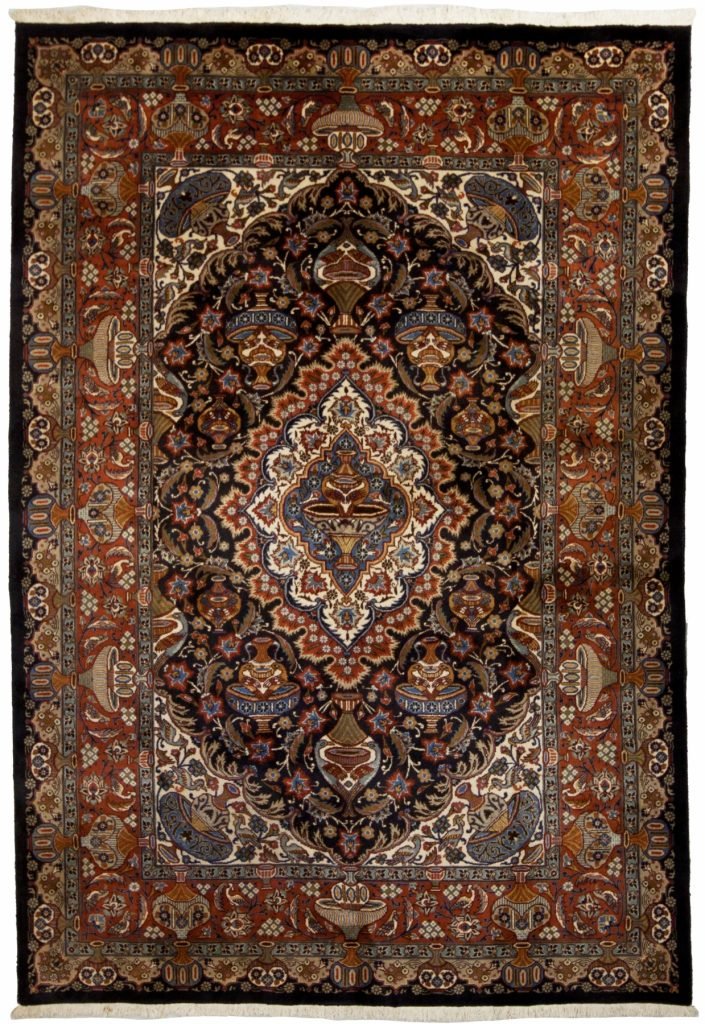
The town of Kashmar is located in Khorasan province, in between Meshed and Birjand (Moud). Kashmar produces a unique design that are typical to Kashmar only. These designs are known by merchants as Zirkhaki(meaning ‘under the earth’) which denotes the pots, vases found in many of the archaeological sites in Iran. In many typical Kashmars these pots and vases are depicted with ancient Persian writing in them. The center of the carpet usually will depict a famous building, mosque or a window into the garden of Paradise. Birds, Persian kings, famous Iranian poets, or historical figures may be incorporated into the design. The quality of materials as well as the weave can vary according to the workshop. Most good quality Kashmars are quite durable and can be as durable as a good quality Kashan. Consequently the prices of Kashmar rugs may range from cheap to more expensive pieces depending on the overall design, wool quality, weave fineness and colors. The most sought after Kashmars are known as “Golden Kashmar” because of the beautiful brown, beige and gold colors. The majority of large pieces today are older usually 20-40 years old since Kashmar weaving has considerably decreased in recent times. The weave is usually 150.000-250.000knot/m2.
Kashmir Silk Collection
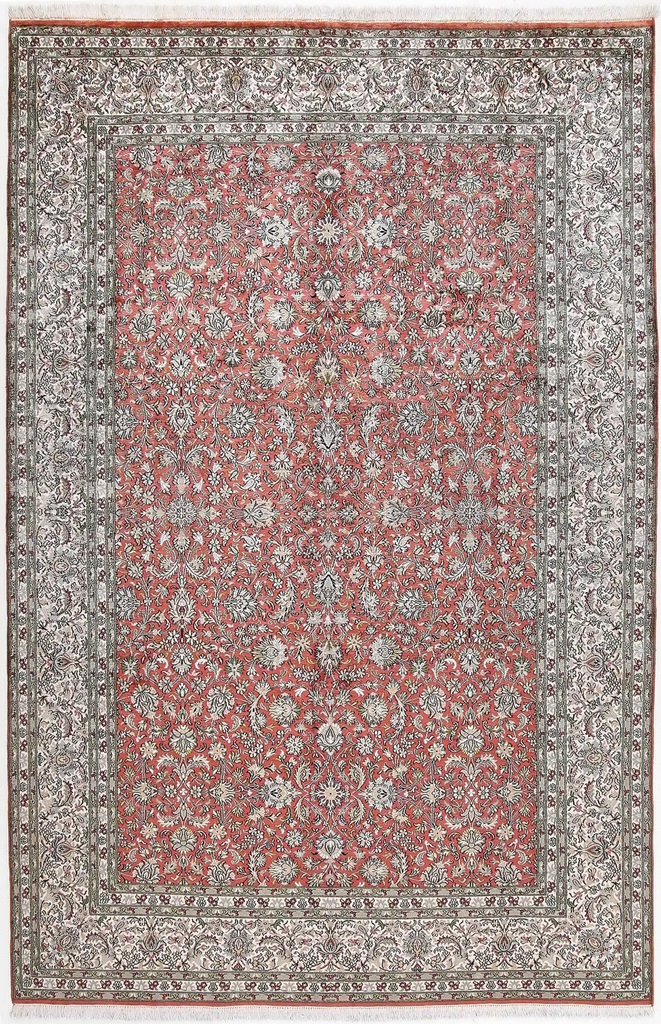
Kashmir region has been producing rugs for about four hundred years probably due to the influence of the the first Muslim ruler of Kashmir, Shah Mir in 1349 and the Mughals, who ruled from 1526 until 1751. However, the commercial carpet industry really began to developed in the late 19th century. The finest silk rugs produced in India are found in Srinagar, Kashmir. Most designs have adopted patterns and designs introduced from Persia. Kashmir silk rugs mainly use curvilinear floral patterns employing the Shah Abbas motifs either with a central medallion or an all-over pattern, employing a field filled with crowded flowers, palmettes, and vines. Kashmir rugs are renowned to have bright, jewel-like color tones such as sapphire blue, ruby red, emerald green, aquamarine, amethyst, and ivory. Rugs from Kashmir traditionally employ oriental, floral designs that typically utilize motifs such as the boteh motifs, Central medallion, Prayer rug pattern, tree-of-life, panel Garden designs which are typically found in the more expensive Qom rugs.
Kashmir rugs are made in a range of sizes and qualities. The usual quality found is what is referred to as a 16/16 (16 knots by 16 knots) per square inch or an 18/18(18 knots by 18 knots)per square inch. In metric this would be 360.000knots/m2 and 500.00knots/m2 respectively. These qualities usually are not so durable and may have a mixture of mercerized cotton(‘art silk’) and natural silk in the pile which considerably reduces the durability and price of the rug. The warp and weft of 16/16 and 18/18 rugs are usually cotton. At Bizsan we recommend the higher quality 24/24 (24 knots by 24 knots) or 26/26(26 knots by 26 knots)per square inch(approximately 900.000-1000.000knots/m2) because genuine pure unmixed silk is used for the pile and the warp making the rug more durable and valuable in the long run. These qualities begin to be comparable to the Iranian Qom rugs but are much lower in price than there counterpart. In the last few years Kashmir rugs are becoming the preferred silk rug due to the limited numbers of silk rugs produced in Qom, Iran and the much higher prices Qom’s rug are demanding on the market.
Kerman
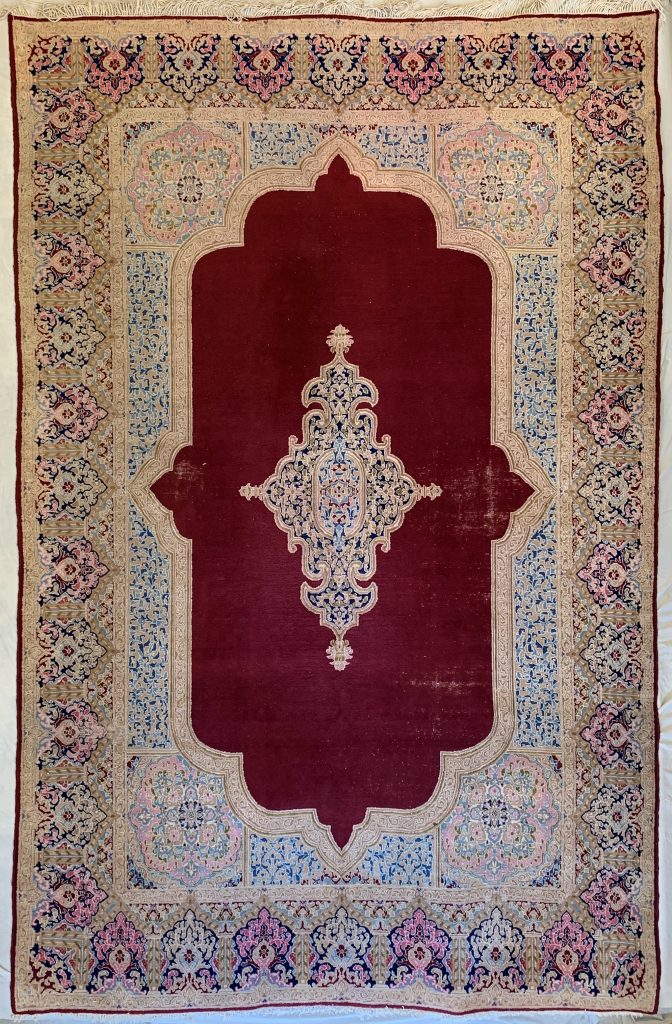
The following rug is a fine specimen from Kerman. The city of Kerman is located 1064 km southeast of Tehran. Carpet weaving has been part of this cities culture since the 16th century. The designs of Kerman rugs are typically repeated medallions or a central medallion with palmettes and arabesques in the background. The overall background was typically dark-blue with red, green, ochre, and light blue.
After World War II, designs were inspired by French Aubusson carpets.
All sizes were woven, from small mats to large gallery size carpets.
Some of the finest rugs woven during the late nineteen century and early 20th century are known as Ravar Kermans, produced in a small village of Ravar, 140km north of Kerman. Today the carpet production of kerman is limited making the rugs scarce and collectable.
Khal Mohammadi

Khal Mohammadis represent some of the best of Afghan weaving today. In actuality, Khal Mohammad is an Ersari Turkaman type of rug produced by Afghan refugees in Pakistan. Generally the Khal Mohammadi rugs are better than their previous Ersari types. There is a higher quality type which is about twice the price called Beljik. The wool is cut short and the quality of the wool is lustrous. In Beljik types both the knot count is higher and the quality of the wool is much better.
Khal Mohammadis are usually from rust brown colour to cherry red. There designs are geometric and have a consistent all-over pattern similar to there Ersari cousins. Khal Mohammadis represent good value for their price because they are generally are lower in price than the Turkamans. They are also a good wearing carpet and can be put under tables.
Loribaft
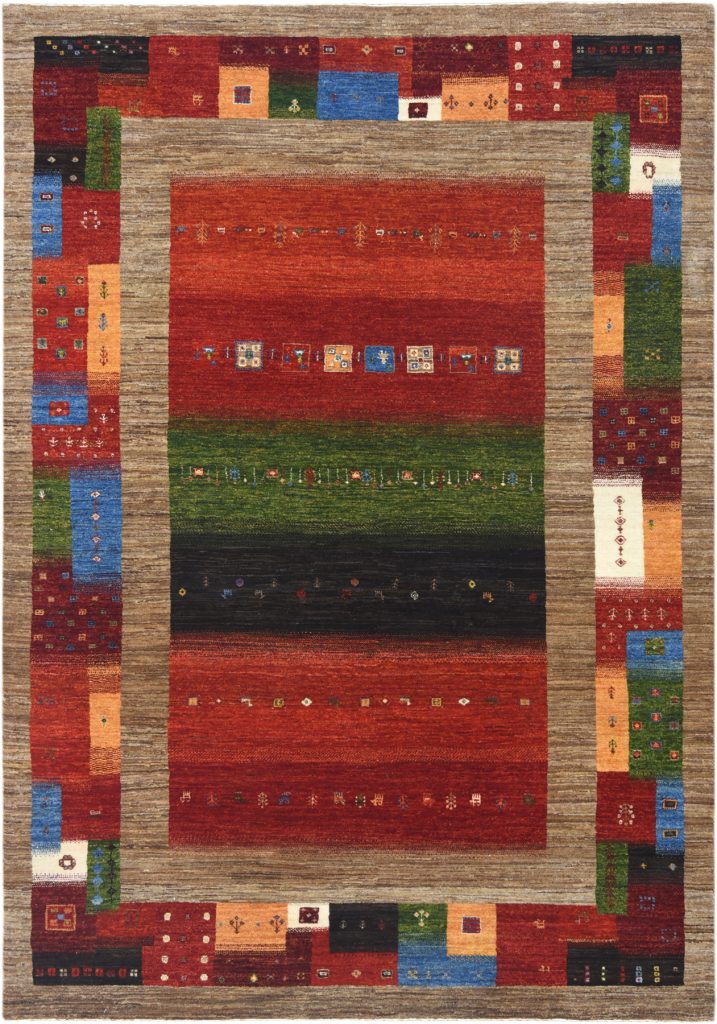
Loribaft are rugs woven by Lori and Qashqai tribal descent people. The word baft means weave, therefore Loribaft means Lori weave! Loribaft rugs are a progressive quality enhancement, both in weave density and pile structure to their predecessor, the Gabbeh rug. Most Gabbeh rugs were 60000-100000knots/m2 while the Loribafts which are woven by Lori and Qashqai are anywhere from 150.000-350.000knots/m2. Not only is the weave better in quality but in most cases the wool is of a finer standard. The dyes utilized in these rugs are also natural, meaning that they have been derived from local plants, either bark, husk,root,or shell used to color the hand-spun wool giving a wonderful marble and painted effect in the carpet field. This effect is probably gives these rugs their greatest appeal due to the impressionist whimsical expressiveness they exhibit. These pieces are usually found in small pieces and larger 2x3m or 2.5×3.5m are quite rare. The designs usually comprise of simple linear geometric expressionist designs rendered from the imagination and characteristic of the simple nomadic life of these pastoral groups. The designs may contain animal, plant and human figures.
Gabbeh’s have been reproduced in other countries, however it becomes immediately visible by the common person that they lack the natural and original beauty which comes from every incomparable piece produced by the original creators and the natural dyes which give these rugs their uniqueness.
Mashhad
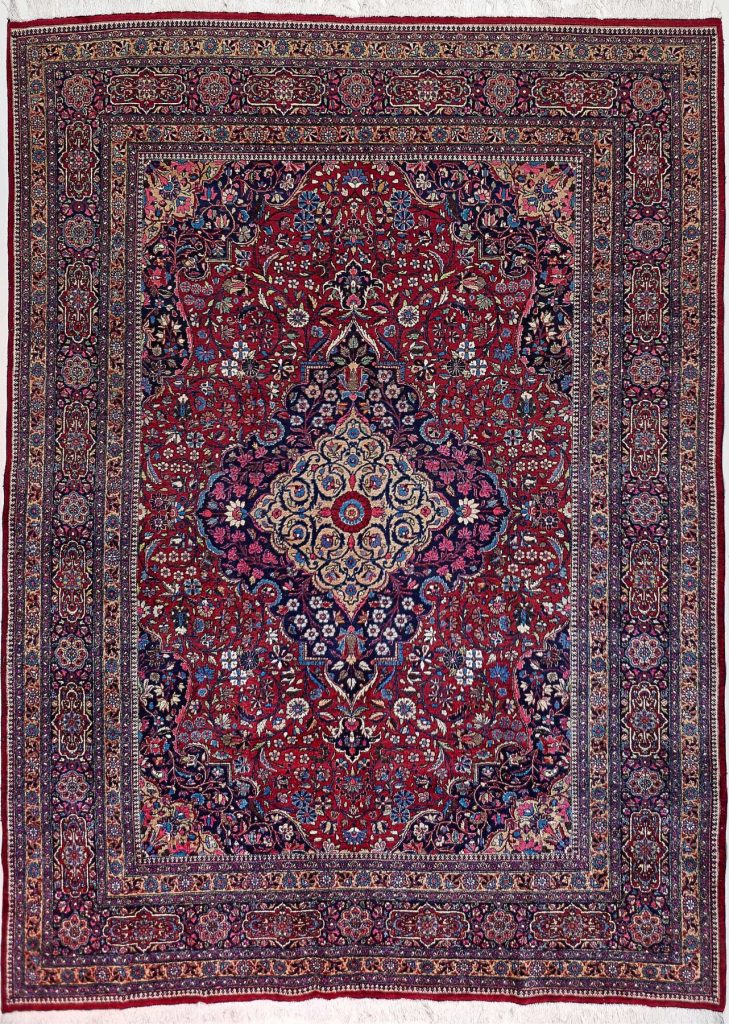
Mashhad is the capital city in Khorasan and important holy city because it is the location of the shrine of Imam Ali Reza, and consequently attracts a great number of Shiite pilgrims. The Safavid dynasty (1502-1736). Mashhad is a major carpet center of Iran producing carpets since the 1500‘s. It is also a center of carpet market for many producers from nearby towns and villages. The majority of the carpets produced in Mashhad are floral either with a central medallion or employing an allover pattern. Usually carpet are produced with varying hues of red or blue predominantly however, other color combinations may be also available. The wool used is usually soft, lustrous and quiet resistant to wear. One of the finest Mashhad carpets produced during the 20th century.
From all the famous rug and carpet workshops in modern Persia, the the most celebrated, distinguished and most sought after are the Amagholi rugs of Mashhad and later on his contemporary and student, Saber.
Amagholi, known by most carpet connoisseurs as Amoghli were two brothers(Abdul Mohammad Amoghli-eldest brother and Ali-Khan Amoghli-youngest brother), originally from Tabriz who migrated to Mashad and produced the most exquisite carpets for their time(1900-1940s). These carpets were mainly produced to supply the demand of the last Pahlavi Royal family of Persia and other aristocrats of the time. It is for this reason that most of Amoghli carpets decorated the Shah’s palaces or the great Mosques of Iran. Amoghli rugs together with such masters as Habibian Nain and Seyrafian Isfahan rugs are the finest Persian productions of the 20th century and comprise of the efflorescence and renewal of the “Persian art of weaving”. Only the carpets of 17th century produced during the Safavid dynasty(1502-1736), established by Shah Abbas of Persia could be compared to these masterpieces. Amoghli carpets are rarely available in the general market due to the high demand of collectors in acquiring such pinnacles of artistry and excellence. Most are acquired through well known Auction houses or well established Carpet galleries. The sign of a Amoghli carpet is distinguishable by a signature 3-5 centimeter wide border with very finely worked endings. The carpets produced by this Amoghli workshop’s also feature the highest density knots produced in Mashad (up to 1360knots/square inch, approximately 2 million knots/m2) however most were produced around 900 knots/square inch. The higher density weaves usually employ silk warp and weft, while less fine pieces will utilize cotton warp and weft. Both qualities will feature the highest quality wool and/or silk in the pile.
Dorokhsh Moud

This is a small town approximately 400km south of Mashad. These rugs also come with a herati pattern usually in an ivory background with or without a medallion. The quality of rugs produced range from good(known as Moud or Birjand) to excellent quality (known as Dorokhsh Moud or Moud produced by Sherkat Farsh). The finer Mouds utilize white or beige silk to accentuate certain details. Their designs vary from Bijars because the designers utilize stronger and brighter colors such as orange, green and rust, pink, yellow, turquoise, sometimes the finer specimens are accentuated with silk. The borders often contain a cartouche motif on a rust-terracotta or blue background. There medallions are usually floral and curvilinear rather than geometric. The medallions are either round jewel forms or quarter spandrels. These rugs provide very good value and quality for a reasonable price. Most mouds have been produced in large sizes but a few small pieces sometimes may be available.
Nain (4-La, 6-La and 9-La)
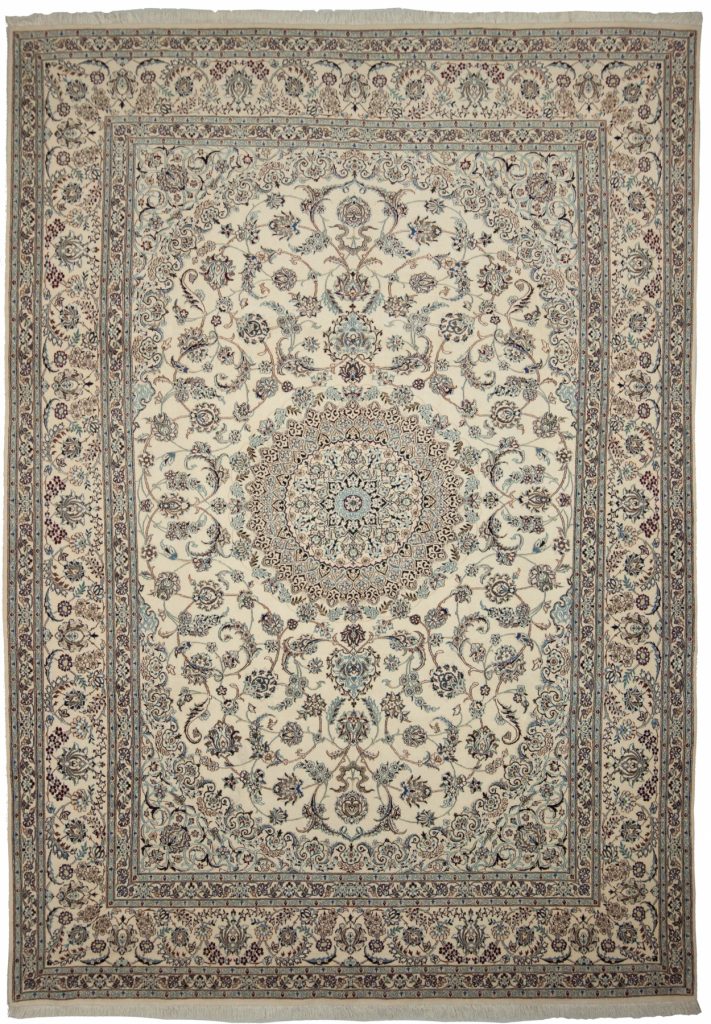
These rugs are one of the finest rugs produced in Iran woven in master workshops. Nain has been producing fine rugs since the beginning of the 1930’s. These rugs utilize excellent quality wool either from Iran or imported from New Zealand. Their traditional colors are blue, beige, white, and shades of brown however some pieces are produced in red or green. They also use silk to accentuate the floral motifs which are executed with time-honored experience and skillful hands.
The quality varies with the price. The rarest specimens being the 6-la and 4-la rugs which are masterpieces of design and beauty woven with six-ply or 4-ply cotton. This technique designating the quality of the rug and the closeness of the weave is exclusively utilized by Nain workshops. As can be expected the prices of Nain’s vary according to the quality, design and workshop. The most sought after Nains are known as Habibian Nain’s. These rugs were named after the great master workshop weaver and designer, Fatollah Habibian known as the “Father of Nain rugs”. Nain rugs are wooven in all sizes and today the rug workshops in Nain are still prolific in their creativity.
Antique/ semi-Antique rugs of Nain (the earliest and most collectable pieces usually named as Nain Tudeshk) represent one of the best “modern” periods of carpet weaving in Iran comparable to the sixteenth and seventeenth century Safavid court carpets in opulence and purity both in color combination and design excellence. The Nain Tudeshk rugs were produced with exceptional quality and attention to detail but in limited number during the beginning of carpet production in Nain from 1917-1928. Most of these exceptional pieces were not produced for export but rather for the new rich during Reza Pahlavi’s reign. The knot count on these rugs varied from 500.000 knots/m2-1.200.000 knots/m2. The movement to establish master handmade rug workshops in Nain occurred after the Aba(woolen outer garment worn during the nineteenth and early 20th century usually by mullah’s and/or Muslim Clerics.) market collapsed. with the import of western style of fashions and fabrics the aba cloth-weaving trade went into decline and presumably the looms were converted to the manufacture of fine handwoven carpets.
Persian court with King and mulla’s wearing aba’s.
Persian court with King and mulla’s wearing aba’s
Fatollah Habibian, recognized as the father of Nain rugs and one of the greatest carpet design masters in that town and Iran as a whole, decided to start one of the most recognized carpet master workshops with his brother Mohammad Habibian. Many of these early master pieces produced in the Habibian workshop had 100-120 knots/cm2. Carpets in Nain were woven on cotton foundation, with silk and wool pile. The designs were initially influenced by Isfahan patterns, since these cities are located within 150 km in proximity to each other. However mid-way through the 20th century there was a change which differentiated Nain rugs to there counterpart. Both there designs and colours became independent of Isfahan rugs by use of more bluish hues, pale brown, cream, ivory and white tones in there colour palettes.
Nasrabad
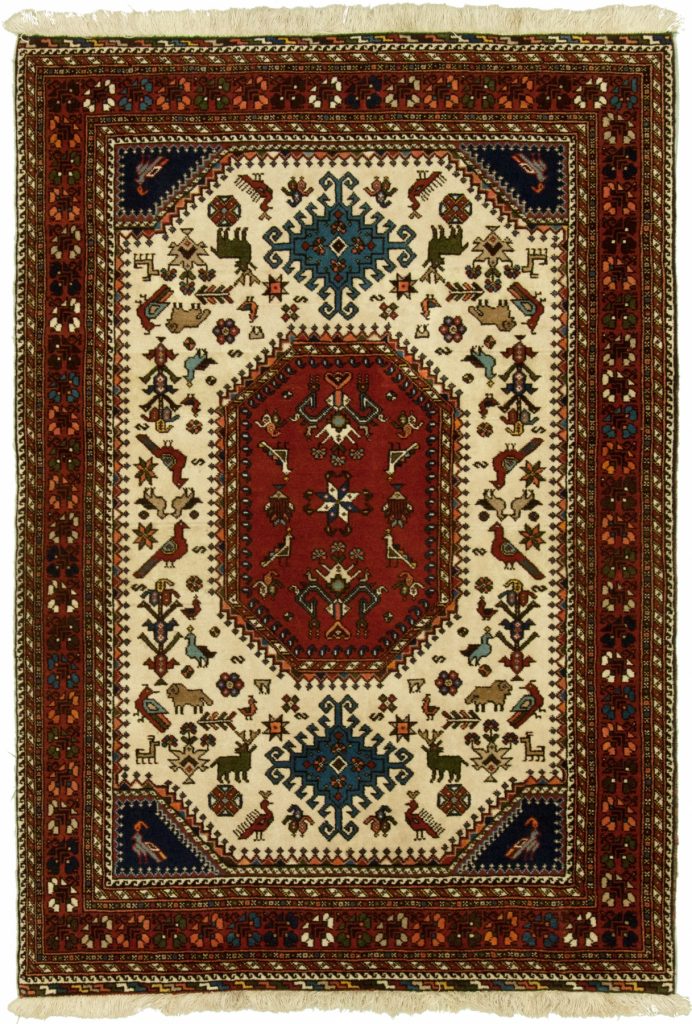
This kind of carpets are made by the Afshar tribes in Iran. Nasrabad carpets are very high quality rugs that are produced near the city of Isfahan. Due to the similar pattern of geometrical flowers Nasrabad rugs often are seen as Kashkouli carpets. They also use figurative patterns. The pile is strong and durable. In some Nasrabad carpets central medallion patterns are woven, which make them easier to differentiate from Kashoulis. The wool quality is excellent which gives a Nasrabad rug a long live. Similar to Bidjar rugs the knot count goes from 180.000 to 250.000 Knots per sqm. Due to tight knotting it is not recommend to fold the carpet but rather to role it. Nasrabad sizes are small to runner size.
Nepal
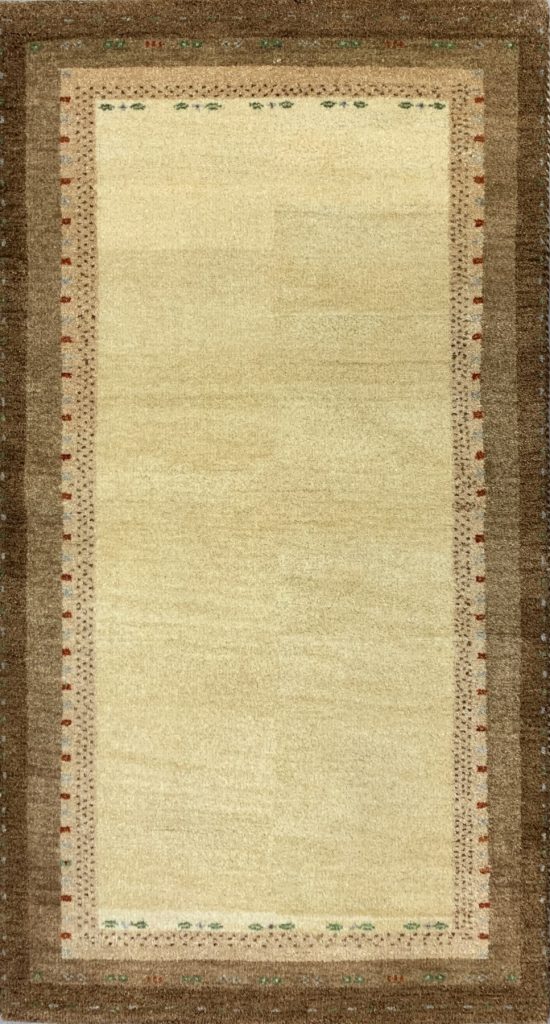
Nepali rugs have expanded from a small industry in the 1970’s to becoming one of the big producers of traditional tibetan design and modern handmade rugs today. Both high-quality New Zealand and Tibetan wool are used making a thick excellent weaving rug. These rugs are woven utilizing both the asymmetrical and Tibetan knotting techniques which results in a dense heavy pile. Excellent swiss dyes are used in addition to natural dyes. Different patterns may be employed ranging from traditional tibetan designs with bright colors(medallion designs, floral patterns, and animal patterns such as cranes, snow lions or mythological creatures such as the stylized dragon or phoenix) to the more subdued Art-Deco and modern contemporary patterns depending on the trends of the European market. In general the design patterns in Nepalese and Tibetan rugs are simple and not concentrated with too many colors and motifs which make them sought after by contemporary interior designers. There may or may not include borders in the general design of the rug depending on the pattern that has been deployed.
Nimbaft

Nimbaft rugs are produced in Iran, Pakistan and Afghanistan employing diverse eclectic nomadic designs. However the most unique pieces are found individually woven by the nomadic and semi-nomadic people living in the South and South-Eastern parts of Iran. Iranian Nimbaft rugs employ two types of weaving techniques which makes them unusually attractive and bold in character. Nimbaft rugs are woven partly in fine Soumak needlework and partly employing finely hand-woven Persian single knots. The finer Nimbaft rugs qualities utilize soft merino wool dyed with natural colors in the pile. The Soumak sections of the rug should be fine and sturdy in structure. Wool is also utilized for the warp and weft making the rug quite resilient to wear and tear. There are few carpet weavers living among the tribal people of the south and southeastern parts of Iran with the skill necessary to employ both these weaving techniques on the same rug. Due to the rarity of such craftsman, Iranian Nimbaft rugs are quite rare and collectable. These rug’s are usually woven in small mats however, larger pieces (2mx3m, 2.5mx3.5m) are quite infrequent and difficult to procure.
Nomad Silk Collection

These handmade rugs are produced with high quality silk both in the warp, weft and pile created in small exclusive master workshops located near Mashhad, Iran. In the last 20 years these pieces were created in limited number and therefore are a rarity and are collectable.
Renaissance
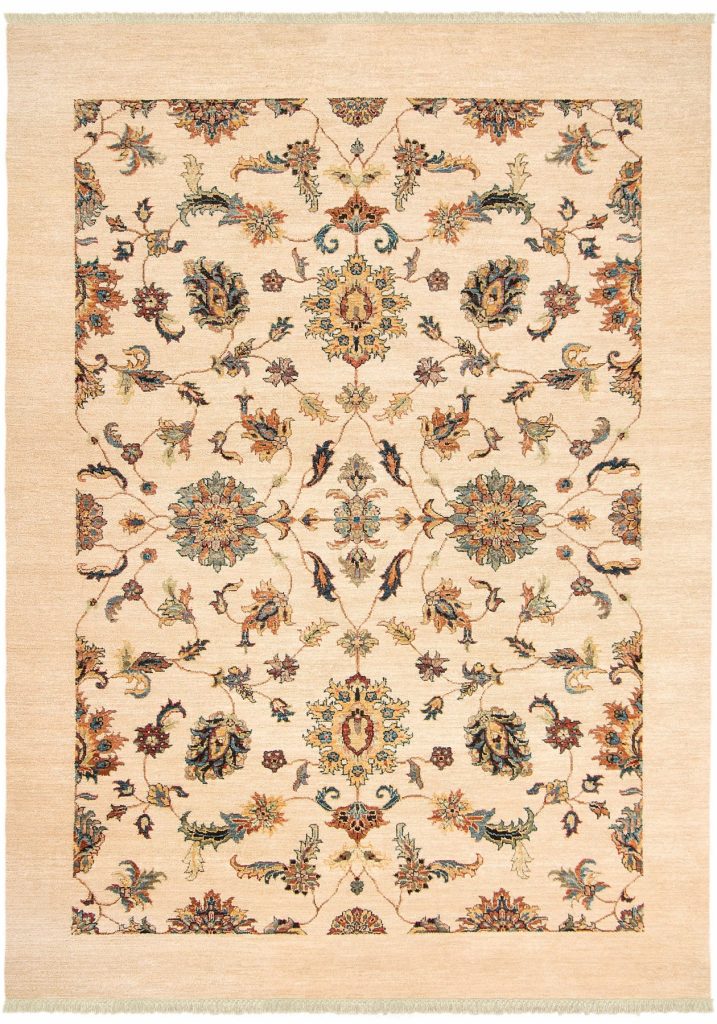
The rebirth of the classical motif implemented into a modern palette offered in a variety of original background colors is what makes the Renaissance motif so original and unique. The character and durability is the result of a mixture of New Zealand wool and the Indian Bikaner wool from Rajasthan. The timeless elegance featured in the design along with with the sturdy structure of these rugs offers a beauty to any home be it classical or modern in design. Offered exclusively at Bizsan Rugs.
Sarough
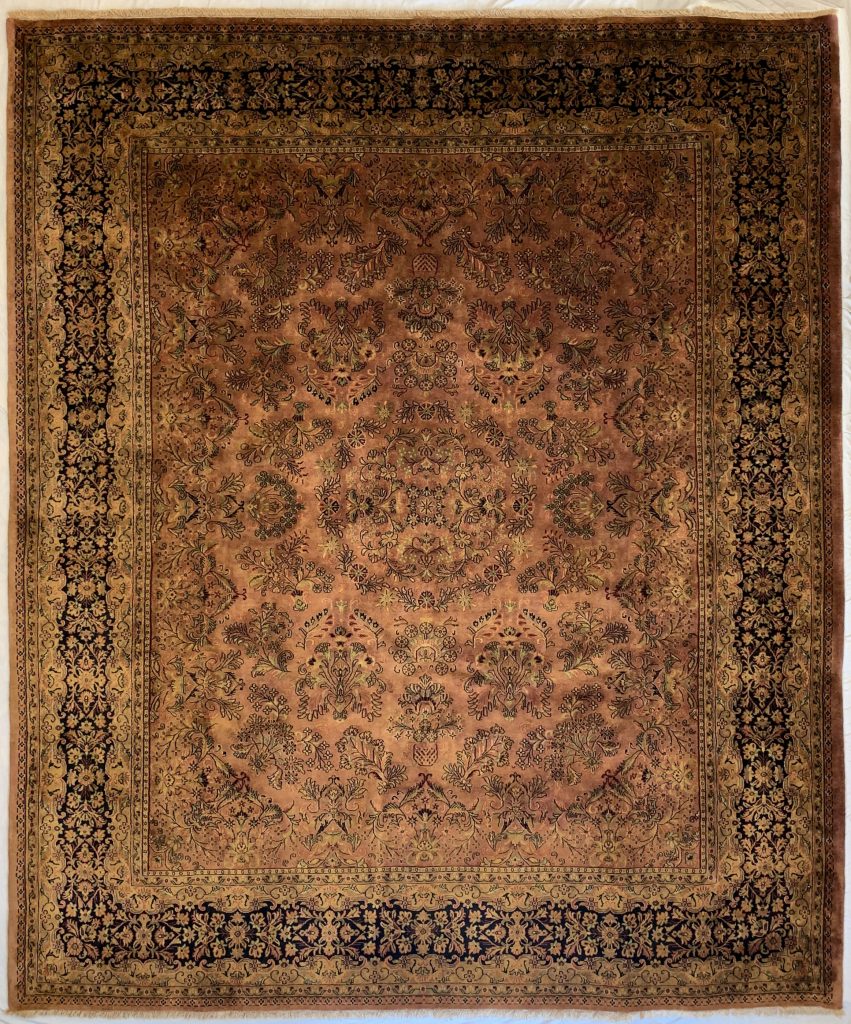
Handmade carpets produced in Sarough are the finest produced in the Arak region of Iran. The handmade carpet tradition has been around in this region for more than one century. Sarough Handmade rugs had their golden age in the 1920’s when this Sarough handmade rugs became very popular in the United States. Most of the designs in those times and today have a central floral bouquet with a field containing vases, palmettes and detached floral sprays. Sarough handmade rugs employ excellent quality lustrous wool. Primary Sarough handmade rugs are navy blue, red, cream or pink-salmon. The antique rugs of the 1920’s specially in large sizes are sought for by collectors and they can be quite expensive depending on their condition.
Senneh
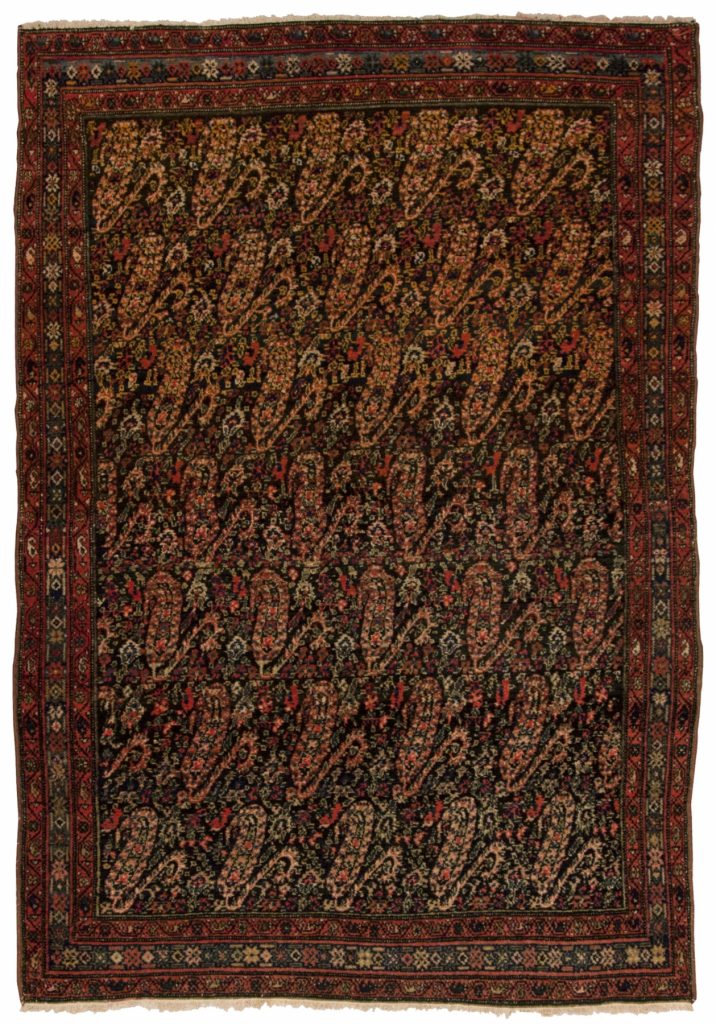
Senneh rugs are produced in the town of Sanandaj which is the capital city in the province of Kurdistan. The population of this area primary consists of people of Kurdish descent. The weaving style although symmetrical is very unique compared to other carpets of Iran and hence can be easily identified from the back of the pile. Although Sennah’s are finely woven, due to its unique structure, the body of a Sennah rug is much thinner than that of a bidjar. The designs that are typically and traditionally utilized on Sennah rugs are one to three central, lozenge-shaped medallions on a dark-blue field comprising of small geometrically shaped Herati motifs. Other designs that may be used are boteh patterns, or flower bouquets spread throughout the field of the carpet. Today the traditional Sennah patterns are becoming rarer as the production of handmade goods is decreasing due to the industrialization of Iran as a whole. Most Sennah rugs are produced in smaller sizes(120-140×200-230) although larger do exist. This province also produces a large amount of the finest kilims available in the region. There designs are crisp, fine and utilize strong colors (blue, red, orange, white, beige). The Kilims have similar patterns and motifs to the Sennah rugs.
Shahrizad

Shahrizad is the mysterious name of an impressive collection, in which each carpets is made from the hands of skillful weavers in Aurai (India) and thus is unique. The basis of this combination of traditional elements and the harmony of color is the hand spun New-Zealand wool and the enigmatic and filigree motifs from the Persian and Caucasian area. For the dying of the wool, vegetable colors are used such as walnut, pistachio, indigo or the colors of the Kermes-bug. The ancient charm of these pieces is attained through the careful washing with tea and herbs.
Shiraz / Qashqai
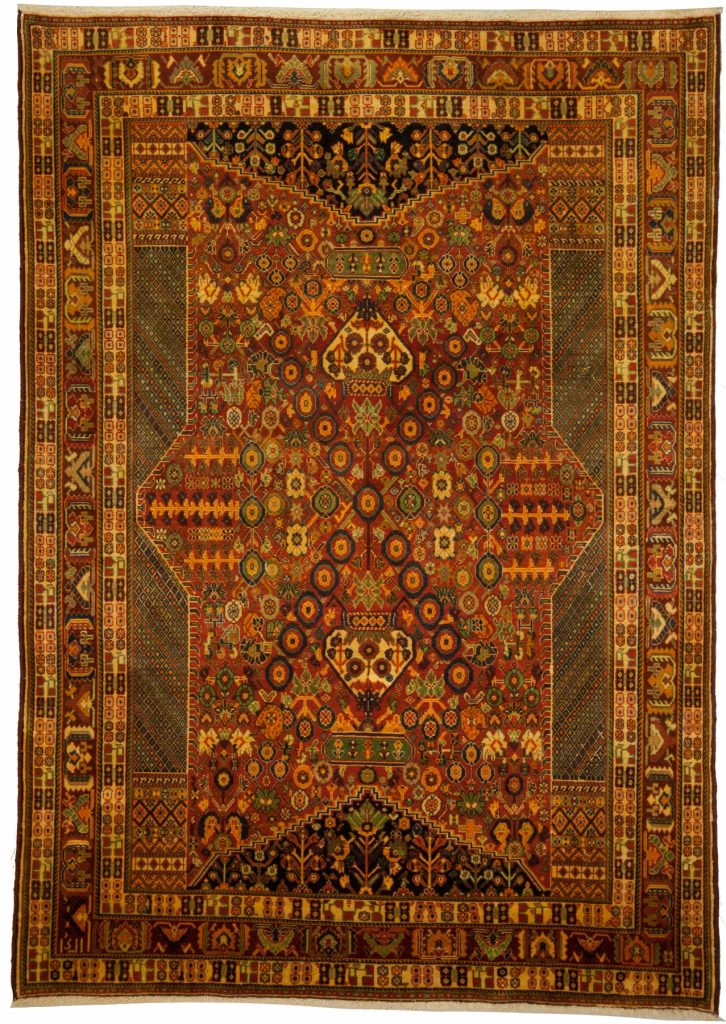
Qashqa’i comprise of the biggest tribal group of Iran. They live in many regions in the surroundings of Abadeh, near and around Isfahan all the way to the Persian Gulf.
These people were traditionally nomads, sheep herders who moved between the highlands and lowlands of the Zagros mountains looking for adequate pastures for their livestock. Today, the way of life of these people have changed, and many have settled in villages and towns. The women usually do most of the weaving. Older Qashqa’i’s rugs utilized vegetable dyes however, today most employ chemical dyes. Those that still do utilize vegetable dyes (Kashkouli, Loribaft) are woven finer and are much more expensive than the typical 100.000-150.000knot/m2 Qashqai. There are a variety of designs employed usually filled with small geometric birds, animals, human figures, floral motifs and also traditional motifs such as botehs, medallions, and stripes. The primary colors used is blue and red. Other colors such as orange, yellow, green and white are used to accentuate details in the field of the rug. Most Qashqai rugs have a rough rustic feel and truly reflect tribal creativity and design. Qashqa’i’s rugs utilize both wool and goat’s hair, the warp and weft are usually mix dark and light wool which can be seen in the fringes of the rug. Qashqa’í’s also weave modern looking Gabbeh rugs. Qashqa’í’s are usually inexpensive and reasonable for the decorative appeal they have making them sought after in the market. Qashqai’s are typically woven in small sizes up to sizes of 2x3m.
Sirjan
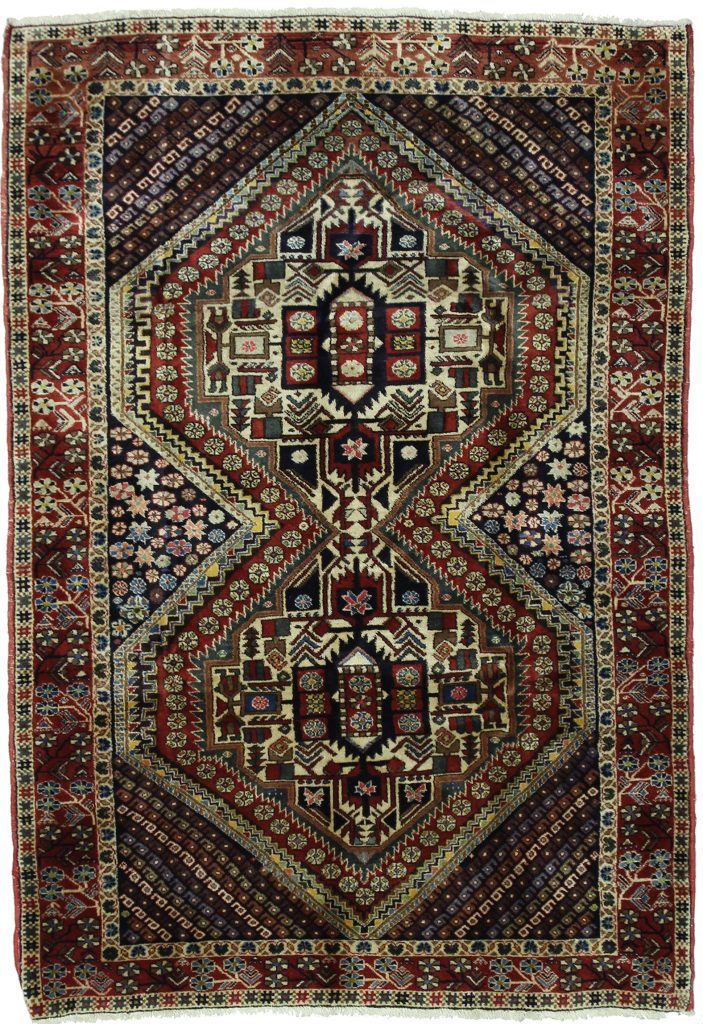
Sirjan is the largest weaving center for Afshari handmade rugs. It is located south-west of the city of Kerman which has been a major carpet weaving center of Iran since the 16th century. Sirjan handmade rugs are woven by Afshari nomads and villagers who live in this area. The patterns adopted can vary from floral to more geometric which have a rustic feel and design. The variety of designs available by the sirjan weavers make it sometimes difficult to determine the origins of these handmade rugs. However, in general they are a strong structured and sturdy carpet which are able to withstand much wear and tear. Furthermore, the qualities available may vary from loosely knotted examples to very fine pieces and consequently the prices also vary accordingly.
Tabriz
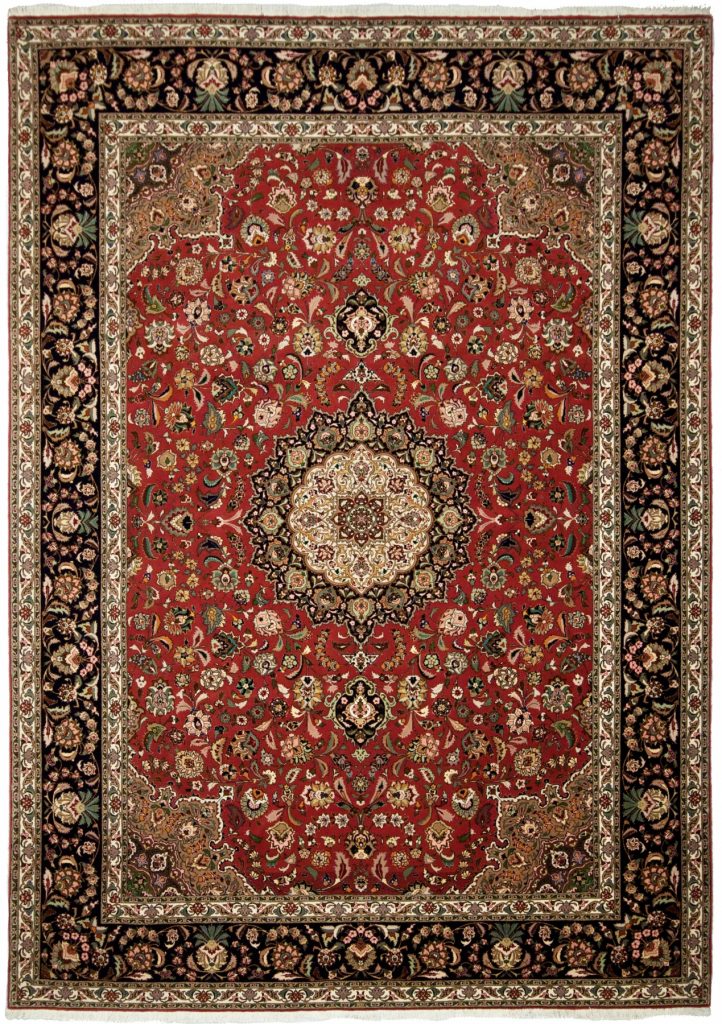
Tabriz (Mahi design): The weavers of these master workshops are the fastest and most skilled in Iran. Tabriz has one of the world’s finest wool rugs available in the market. The wool is excellent, Merino wool being the preferred quality utilized for Bizsan’s collection. Although there is a range of quality and variety of Tabriz mahi’s woven in and around Tabriz, the most common type of is 350.000knot-500.000knot/m2. This is denoted among rug merchants as Tabriz 40 radj or 50 radj. A radj is a measure equal to the length of a Persian cigarette, approximately 7 centimetres. Therefore a 50 radj rug is approximately fifty knots in 7 centimetres. The 60-80 radj Tabriz rugs are quite rare and prices reflect the number of these masterpieces woven in Tabriz. Silk is also utilized in finer pieces to accentuate details in the rug design. The Mahi design is composed of small intricate herati motifs repeated throughout the field of the carpet. These rugs are used either in modern or traditional rooms giving that special elegance and beauty to the space. The Tabriz Mahi gets its inspiration from Haji Jalili tabrizes woven around 1875.
Tabriz (Floral Design): The weavers of these master workshops are the fastest and most skilled in Iran. Tabriz has one of the world’s finest wool rugs available in the market. Although there is a range of quality and variety of rugs woven in and around Tabriz, the most common type of Tabriz is 350.000knot-500.000knot/m2. This is denoted in Tabriz as 40-50 radj. A radj is a measure equal to the length of a Persian cigarette, approximately 7 centimeters. Therefore a 50 radj rug is approximately fifty knots in 7 centimetres, which is approximately 500.000knots/m2. The 60-80 radj is quite rare and prices reflect the number of these masterpieces woven in Tabriz.
The wool utilized in most Tabriz master workshops is excellent quality, merino(kork wool) being the preferred quality utilized for Bizsan’s collection. The most common quality ranges from 500 000-600 000 knot although there are rare pieces that are 60-80 radj(750.000-1.300.000knot6m2), as a result the prices also reflect the number of these masterpieces woven in Tabriz. Silk is also utilized to accentuate details in the rug floral motifs. The floral patterns vary, either spread throughout the field of the rug with no central medallion or incorporated with a central medallion. The wide variety of pastel color combination’s used in these floral motifs are truly particular to the master workshops of Tabriz and no other workshop throughout the world has been able to replicate Tabriz designs or color dynamics sometimes incorporating 50-70 colors harmoniously. The number of rugs produced in Tabriz have become limited resulting in higher qualities and limited numbers woven. These rugs are quite durable due to there construction, wool quality and craftsmanship. Most employ synthetic dyes however a few rare pieces with Heriz designs can be found utilizing vegetable dyes. The most famous antique and sought after Tabrizs rugs are the Hadji Jalili Tabrizes that were produced by this famous workshop and workshops that were licensed by this family. They were produced around the later part of the 19th century(1875). They are known for their unique designs and craftsmanship which crowned this period of Tabriz artistry!
Turkaman

The Tekke are one of the main Turkaman tribes. They are settled in Turkmenistan and is Afghanistan. Previously, the Tekke lived a nomadic life. Today, most of the tribes have settled and live as peace-loving farmers. However, after the dissolution of the Soviet Union some returned to the nomadic way of life. They Tekke mainly live in the now-independent Republic of Turkmenistan, where they weave carpets in the towns of Ashgabat, Mari and surrounding areas.
During the communist revolution many Tekke clans emigrated to the neighboring states of Afghanistan and Iran. These carpets are famously known as Bukhara (or Bochara). Thes designs are also copied in Pakistan but utilizing a much lower quality wool. The Turkaman Bukhara is the precursor for all current Bukhara types and is considered high in wool quality and craftsmanship. It is possible to recognize which tribe produced the carpet from the different primary patterns used, called güll, or gol. The Tekke Gul is one of the most famous motifs.
Turkish Hereke

Hereke is located approximately 65 km east of Istanbul and is where the finest rugs are produced in Turkey. Originally the workshops in this town were established by the government as the imperial factory to weave the finest carpets for the Ottoman court. Although Hereke produced both wool and silk carpets it is world renowned for its double knotted silk rugs. Large silk carpets are rare and most are woven in smaller sizes. Many different designs are utilized, however most are adapted from Persian classical motifs. Most patterns are curvilinear utilizing floral patterns, vines, tendrils which fill the general field of the carpet with a central medallion. Sometimes paradise garden designs may also be woven with birds and other animals. In some prayer carpet designs the upper cartouches may have Arabic script from a renowned poet or “The Quran”. In some rare unique pieces created 30 years ago the motifs were accentuated by gold and silver threads in a weft-wrapping technique employed by Armenian weavers which gave a unique three dimensional relief effect to the carpet. These pieces are rare and very valuable. Most Hereke carpets will have the name of the town in the border written with arabic script. These are excellent quality rugs which are highly sought collectable pieces and are foreseen to appreciate due to the limited numbers that are produced.
Turkish Kars

Kars is located in the Northwestern part of Turkey, 75 km from the Armenian border.
Historically it is a city founded by the Armenians in the 8th century, however today due to its turbulent history it boasts a much smaller Armenian population. Most handmade rug designs are strongly influenced by Caucasian rug producing centers (Kazak, Karabakh and Kuba). Designs employ one or multiple medallions in varying geometric patterns. The wool used in Kars rugs is coarse, however finer pieces may utilize finer wool and even vegetable dyes. Primary colours are utilized however, they are not as vibrant as pieces produced in the Caucasian carpet centers and often the colours are purrposely muted.
Kars weaving centers produce a variety of sizes but most production is of smaller pieces.
Turkish Kayseri

Kayseri, known as Caesarea under Roman rule is located in the center of present day Turkey, at the foot of Mount Erciyas and known as one of the oldest cities in the region. In Ancient times it was located providentially on the crossroads of Achaemenid Persian trade routes.
Located on these ancient trade routes has also made it a market center for rugs from the surrounding area. Although it should be noted that due to the recent steady industrialization of this region, the handmade carpet production has considerably been affected.
The designs utilized in Kayseri rugs tend to be curvilinear with floral patterns. The field may be filled with vines and tendrils, and animal figures such as birds are often incorporated. The overall design may also include an elaborate central medallion. The materials used are good quality wool, however special pieces are produced with silk pile, warp and weft. Most Kayseri carpets adopt Persian motifs found in Tabriz and Isfahan. After Hereke, Kayseri produced the greatest number of silk carpets in Turkey. However, in recent times there are very few pieces produced due to the recent accelerated development of most major cities in Turkey.
Most kayseri silk carpets use bold vibrant colours. They also employ the symmetrical knot which gives Kayseri handmade rugs a sturdy and robust feel. They are quite durable and may be used under dining tables.
Due to the limited production of Kayseri carpets it is foreseeable that fine wool silk carpets produced from this region will become collectible in the future.
Turkish Uschak
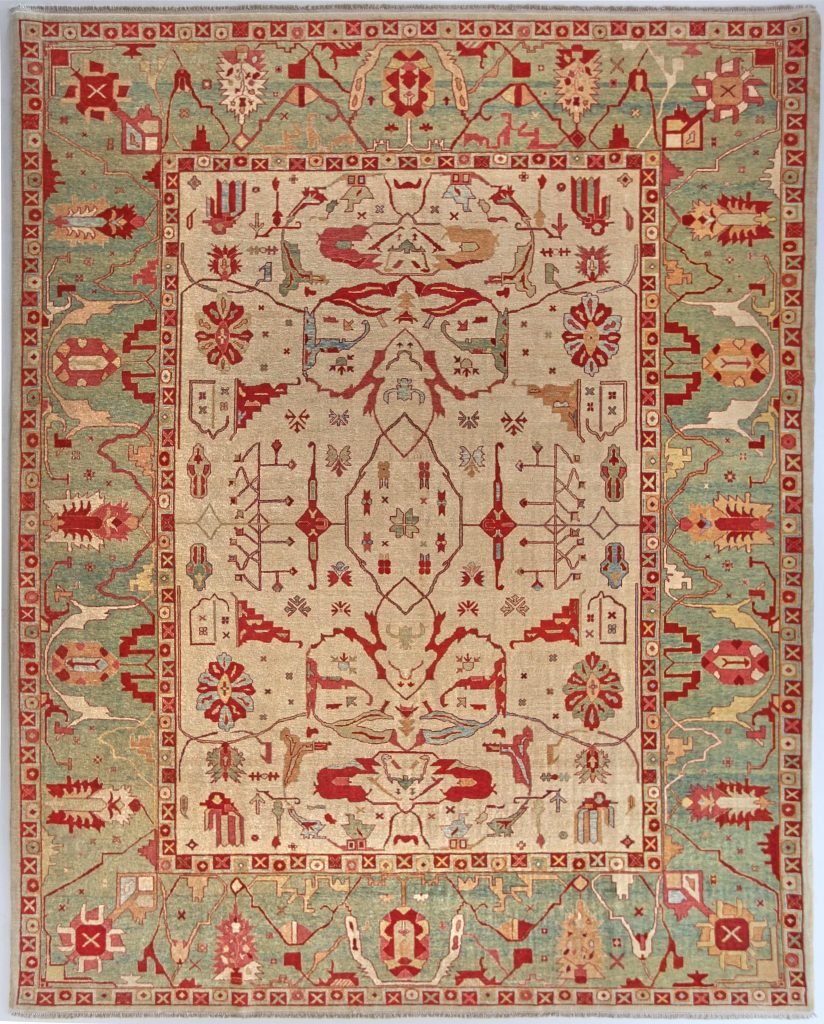
Usak is situated approximately 160 km east of Izmir in Turkey. This was a central hub of handmade rugs for 500 years. Usaks were one of the earliest carpets to reach the European market due to their designs and bold colours. The Usak rugs produced during the 19th century are unlike earlier pieces produced during the 17th and 18th century. The 19th century production were more coarsely knotted and as a consequence were not as durable as earlier finer Usaks which are famously known as the Star and Medallion Usaks.
The designs are similar to the Ziegler rugs produced during the same period in Sultanabad(Iran). They utilized vegetable dyes in beige, red, blue, green and turquoise combinations.
Most carpets produced during this period in large sizes to fulfill the western demand.
Today the production is very small and rare pieces are produced incorporating traditional vegetable dyes in soft colours. They are usually reproductions of classic Usaks but utilize better quality wool and a finer weave quality.
Yalameh
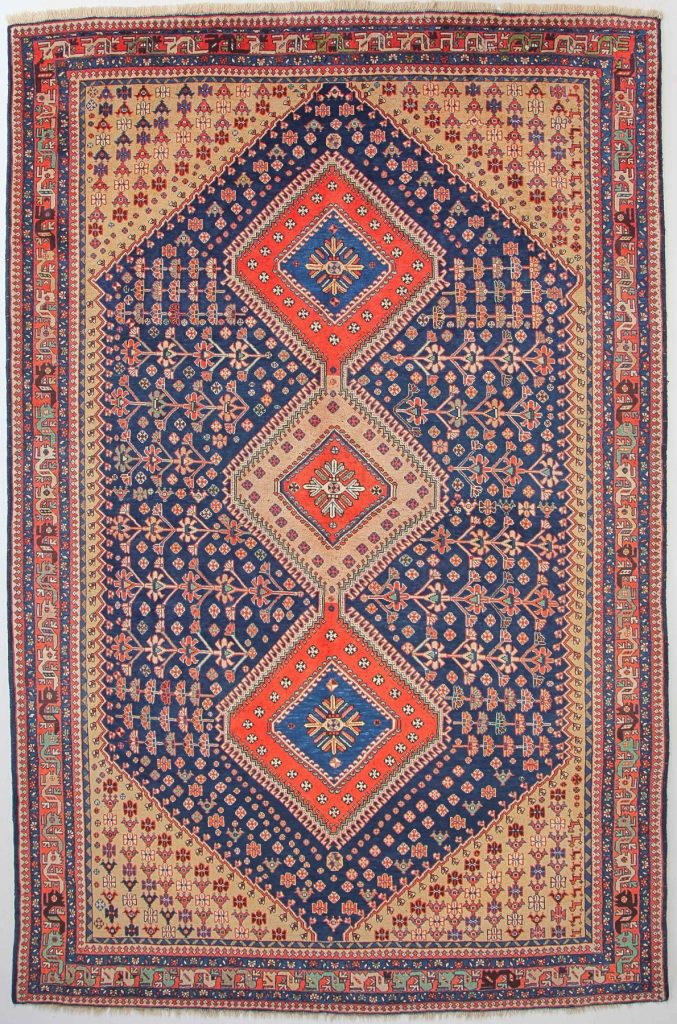
The Yalameh rug does not denote a place or tribe but rather a design inspired from Qashqai rugs woven during the beginning of the 19th century. These rugs are woven both by Qashqa’i tribal people and Persian villagers near Abadeh, and Aliabad. Yalameh rugs are very attractive finer “tribal rugs” woven in different sizes. The majority of Yalameh rugs have diamond shaped latch-hook medallions connected together end to end spread throughout the field of rug. Another design employed is the field is divided into squares where the diamonds are placed. The spaces in between these diamond shaped motifs is then filled with small geometric motifs similar to Qashqa’i rugs. The main color utilized most commonly in yalameh’s is a terracotta brown with warm reds and blues. Other colors such as green, yellow, orange, and white are also used to accentuate details. The wool in most Yalameh’s is a lustrous good quality wool. Most Yalameh’s are more expensive than Qashqa’i’s due to there finer weave and higher quality wool and general craftsmanship. The best quality Yalameh’s are woven in Aliabad. Unfortunately in recent years the weaving of these rugs types have diminished considerably.
Ziegler Farahan
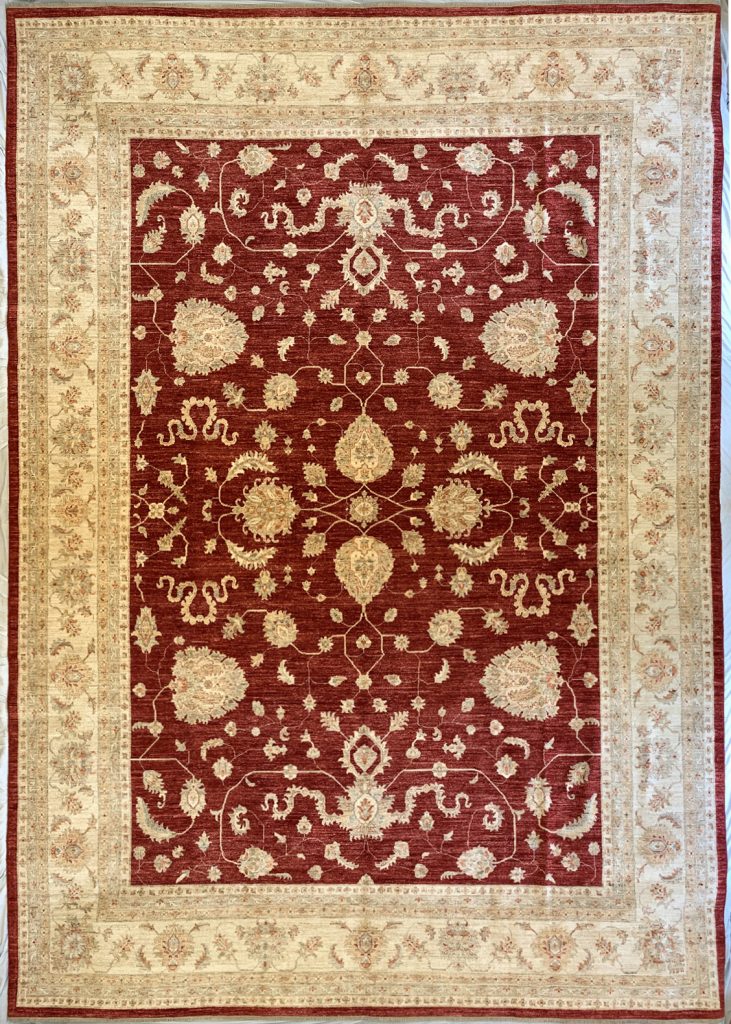
These rugs are replica’s of the late 1880‘s to 1920‘s rugs woven in sultanabad by Messrs. Ziegler and Company, a firm based in Manchester, England. These rugs where produced for the European market, which included repeated floral patterns either in an open field or with a central medallion. Today these rugs are being reproduced in Pakistan and Indian workshops with a wide variety of qualities both in material and structure. This wide variety of rugs produced under the name of “Ziegler” also vary considerably in quality and craftsmanship. Rough pieces can be found at very low prices and spectacular pieces utilizing high quality wool, even merino wool, can also be procured for similar price ranges to high-end Iranian rugs. Most reputable Rug Galleries will have the higher quality of contemporary Ziegler’s.
